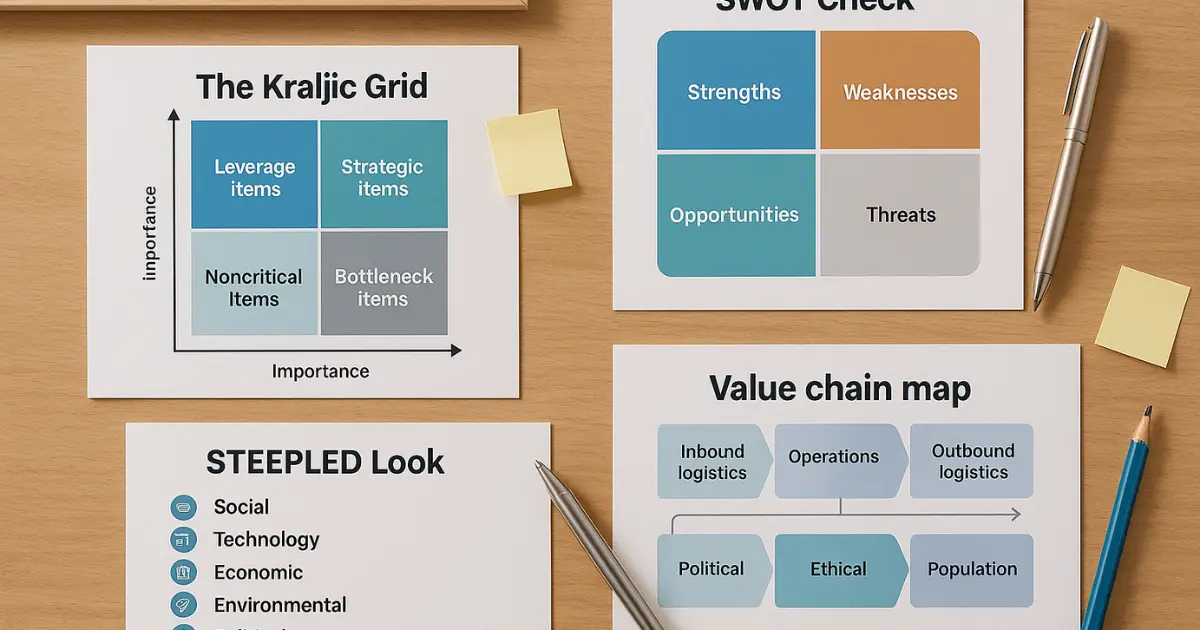
The year 2025 brings new problems like supply chain issues, higher prices, new technology, and people wanting businesses to be more responsible. This means buying teams can’t just look for the cheapest option anymore. They need to think about what’s best for their company in the long run. The perfect fitting procurement and sourcing strategies will keep your work better. Let’s dive in to these.
What Is a Sourcing Strategy in Procurement?
A sourcing strategy in procurement is a plan that helps a business decide how and where to buy the goods or services it needs.
Instead of just going for the cheapest option, it focuses on finding reliable suppliers, building strong relationships, reducing risks, and getting the best overall value for the company.
10 Simple Procurement & Sourcing Strategies
1. Plan Your Buying
Instead of buying things randomly, look at what you spend money on, figure out what you really need, and make smart choices about where to buy everything.
2. Build Good Supplier Relationships
Talk to your suppliers regularly, check how they’re doing, plan together, and work on making things better. Treat them like business partners.
3. Manage Risks
Don’t just have backup suppliers. In 2025, you also need to worry about things like trade wars, bad weather affecting shipping, computer security, and whether your suppliers have enough money to stay in business.
4. Spend Money Smartly
Look at the total cost, not just the price tag. Sometimes paying a bit more upfront saves you a lot of money later because of better quality and service.
5. Work with Different Types of Suppliers
Use suppliers owned by women, minorities, and small businesses. They often have great ideas, good prices, and fresh ways of doing things.
6. Use Technology
Use computer programs that help predict what you’ll need, chat systems to talk with suppliers, automatic ordering, and dashboards to see where your money goes. These tools make buying faster and smarter.
7. Buy Local vs Global
Find the right mix. Buying from far away can be cheaper, but buying locally is faster and easier to manage. Many companies now buy from nearby countries to get the best of both.
8. Predict What You’ll Need
Use data to guess what you’ll need in the future. This helps you avoid running out of things or having too much sitting around.
9. Keep Getting Better
Check how your suppliers are doing regularly. Use scorecards and feedback to always improve your buying decisions.
10. Buy Responsibly
Choose suppliers who care about the environment, treat workers well, and do business honestly. This protects your company’s reputation.
Simple Tools to Build Your Strategy

The Kraljic Grid
This is a simple chart that helps you group your purchases based on how important they are and how risky they are. It helps you decide whether to focus on saving money, building partnerships, or managing risks.
SWOT Check
Look at your Strengths, Weaknesses, Opportunities, and Threats in buying. This helps you know where to focus and what to watch out for.
STEEPLED Look
Think about Social, Technology, Economic, Environmental, Political, Legal, Ethical, and Population factors that might affect your buying decisions.
Value Chain Map
Draw out how buying adds value to each part of your business. This helps you see where better buying can make the biggest difference.
Simple Planning Template
Here’s an easy template you can use:
| What You Buy | Current Supplier | Risk Level | Cost Impact | Your Plan | What To Do | When |
| Materials | Supplier A | High | High | Find more suppliers | Get 2 backup suppliers | March 2025 |
| Office Stuff | Supplier B | Low | Low | Make it automatic | Set up online ordering | June 2025 |
| Computer Help | Supplier C | Medium | High | Work as partners | Meet every 3 months | Always |
How to Pick the Right Strategy
Step 1: Know Your Goals
What do you want? Lower costs? Better quality? Faster delivery? Less risk? Be clear about what matters most.
Step 2: Study the Market
Research who’s selling what you need, what prices look like, and what problems might come up.
Step 3: Know What You Can Handle
Look at your team’s skills, how much money you have, what computer systems you use, and how much time you have.
Step 4: Choose Your Plan
Based on your goals and what you learned, pick the strategies that make sense for different types of things you buy.
Step 5: Do It and Watch
Put your plan to work and track how it’s going. Be ready to change things based on what you learn.
Small Business vs Big Company Approach
Small Business: Focus on building good relationships with a few reliable suppliers. Use simple tools like spreadsheets to track things. Work with local suppliers for faster service and easier communication.
Big Company: Use fancy computer programs for buying, create detailed report cards for suppliers, have formal risk management, and work with suppliers all over the world with complex contracts.
Big Mistakes to Avoid
- Always Picking the Cheapest
The lowest price often means hidden costs – bad quality, late deliveries, poor service, or suppliers who might disappear. Always think about the total cost.
- Having Only One Supplier
Depending on just one supplier for important stuff is risky. What if they have problems, raise prices, or go out of business?
- Only Looking at the Price Tag
Don’t just look at what you pay upfront. Think about shipping, quality problems, returns, training, and long-term costs.
- Not Tracking How Suppliers Do
If you don’t check how your suppliers are performing regularly, you won’t know when problems start until it’s too late.
- Ignoring Rules and Responsibility
Suppliers who don’t follow environmental rules or treat workers badly can hurt your company’s reputation and cause legal trouble.
- Bad Communication
Not telling suppliers what you expect, when you need things, or how they’re doing leads to misunderstandings and problems.
- Rushing to Choose
Taking shortcuts when picking suppliers often means choosing the wrong ones and paying for it later with poor performance.
Final Thoughts
Good buying isn’t about finding the cheapest deal – it’s about creating long-term value for your business. The best buying strategies balance cost, quality, risk, and relationships to build a supplier base that helps your company succeed.
As we go through 2025, take time to look at how you’re currently buying things. Are you getting good value? Are your suppliers helping you reach your business goals? Are you ready for potential problems?
Companies that invest in smart buying strategies today will be the ones doing great tomorrow. They’ll have lower costs, better quality, stronger partnerships, and the ability to adapt to whatever challenges come next.
What buying strategy are you using in 2025? The time to start is now – your future success depends on the buying decisions you make today.
